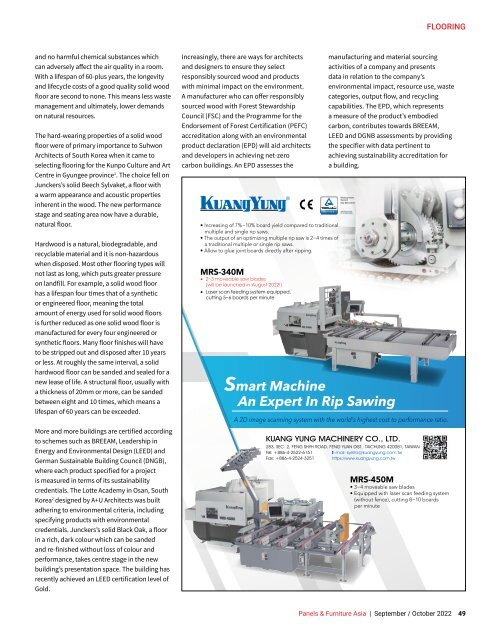Panels & Furniture Asia September/October 2022
Panels & Furniture Asia (PFA) is a leading regional trade magazine dedicated to the woodbased panel, furniture and flooring processing industry. Published bi-monthly since 2000, PFA delivers authentic journalism to cover the latest news, technology, machinery, projects, products and trade events throughout the sector. With a hardcopy and digital readership comprising manufacturers, designers and specifiers, among others, PFA is the platform of choice for connecting brands across the global woodworking landscape.
Panels & Furniture Asia (PFA) is a leading regional trade magazine dedicated to the woodbased panel, furniture and flooring processing industry. Published bi-monthly since 2000, PFA delivers authentic journalism to cover the latest news, technology, machinery, projects, products and trade events throughout the sector. With a hardcopy and digital readership comprising manufacturers, designers and specifiers, among others, PFA is the platform of choice for connecting brands across the global woodworking landscape.
Create successful ePaper yourself
Turn your PDF publications into a flip-book with our unique Google optimized e-Paper software.
FLOORING<br />
and no harmful chemical substances which<br />
can adversely affect the air quality in a room.<br />
With a lifespan of 60-plus years, the longevity<br />
and lifecycle costs of a good quality solid wood<br />
floor are second to none. This means less waste<br />
management and ultimately, lower demands<br />
on natural resources.<br />
The hard-wearing properties of a solid wood<br />
floor were of primary importance to Suhwon<br />
Architects of South Korea when it came to<br />
selecting flooring for the Kunpo Culture and Art<br />
Centre in Gyungee province 1 . The choice fell on<br />
Junckers’s solid Beech Sylvaket, a floor with<br />
a warm appearance and acoustic properties<br />
inherent in the wood. The new performance<br />
stage and seating area now have a durable,<br />
natural floor.<br />
Increasingly, there are ways for architects<br />
and designers to ensure they select<br />
responsibly sourced wood and products<br />
with minimal impact on the environment.<br />
A manufacturer who can offer responsibly<br />
sourced wood with Forest Stewardship<br />
Council (FSC) and the Programme for the<br />
Endorsement of Forest Certification (PEFC)<br />
accreditation along with an environmental<br />
product declaration (EPD) will aid architects<br />
and developers in achieving net-zero<br />
carbon buildings. An EPD assesses the<br />
manufacturing and material sourcing<br />
activities of a company and presents<br />
data in relation to the company’s<br />
environmental impact, resource use, waste<br />
categories, output flow, and recycling<br />
capabilities. The EPD, which represents<br />
a measure of the product’s embodied<br />
carbon, contributes towards BREEAM,<br />
LEED and DGNB assessments by providing<br />
the specifier with data pertinent to<br />
achieving sustainability accreditation for<br />
a building.<br />
Hardwood is a natural, biodegradable, and<br />
recyclable material and it is non-hazardous<br />
when disposed. Most other flooring types will<br />
not last as long, which puts greater pressure<br />
on landfill. For example, a solid wood floor<br />
has a lifespan four times that of a synthetic<br />
or engineered floor, meaning the total<br />
amount of energy used for solid wood floors<br />
is further reduced as one solid wood floor is<br />
manufactured for every four engineered or<br />
synthetic floors. Many floor finishes will have<br />
to be stripped out and disposed after 10 years<br />
or less. At roughly the same interval, a solid<br />
hardwood floor can be sanded and sealed for a<br />
new lease of life. A structural floor, usually with<br />
a thickness of 20mm or more, can be sanded<br />
between eight and 10 times, which means a<br />
lifespan of 60 years can be exceeded.<br />
• 2~3 moveable saw blades<br />
(will be launched in August <strong>2022</strong>!)<br />
• Laser scan feeding system equipped,<br />
cutting 5~6 boards per minute<br />
More and more buildings are certified according<br />
to schemes such as BREEAM, Leadership in<br />
Energy and Environmental Design (LEED) and<br />
German Sustainable Building Council (DNGB),<br />
where each product specified for a project<br />
is measured in terms of its sustainability<br />
credentials. The Lotte Academy in Osan, South<br />
Korea 2 designed by A+U Architects was built<br />
adhering to environmental criteria, including<br />
specifying products with environmental<br />
credentials. Junckers’s solid Black Oak, a floor<br />
in a rich, dark colour which can be sanded<br />
and re-finished without loss of colour and<br />
performance, takes centre stage in the new<br />
building’s presentation space. The building has<br />
recently achieved an LEED certification level of<br />
Gold.<br />
<strong>Panels</strong> & <strong>Furniture</strong> <strong>Asia</strong> | <strong>September</strong> / <strong>October</strong> <strong>2022</strong> 49


















